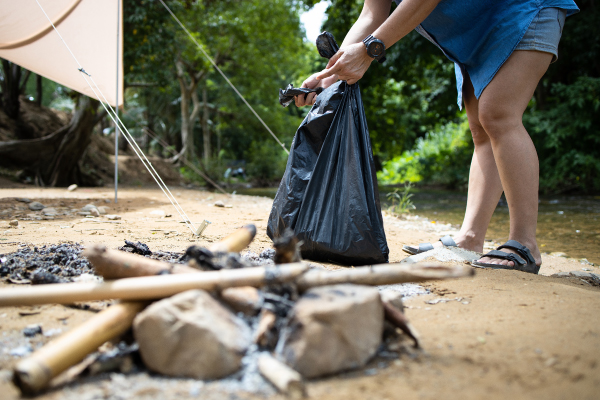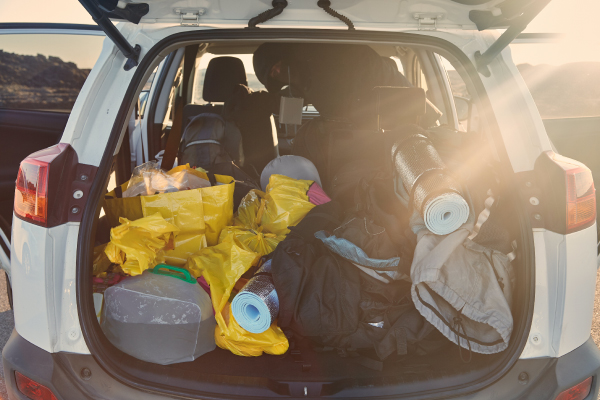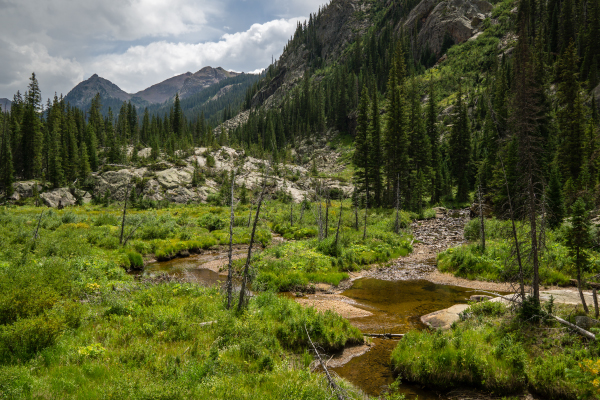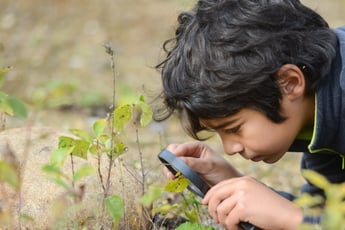Con frecuencia, los visitantes del Walking Mountains Science Center y mis amigos me cuentan historias sobre sus decepcionantes experiencias de campamento. En estas experiencias, alguien llega a un hermoso campamento en nuestras tierras públicas solo para encontrar basura o papel higiénico esparcidos. En otras historias, los campamentos se encuentran desatendidos con fogatas calientes y humeantes que ponen en peligro todo el bosque. Estas historias me hacen preguntarme por qué las personas no siguen los principios de Leave No Trace cuando disfrutan de lugares salvajes. Asumiré que no todo el mundo está familiarizado con Leave No Trace, así que aquí hay una breve reseña. Leave No Trace es una ética al aire libre que se utiliza para ayudar a las personas a recordar que deben dejar los espacios silvestres que visitan en las mismas o mejores condiciones que en las que fueron encontrados. Me viene a la mente la frase “tomar solo fotografías y dejar solo huellas”. Hay siete principios Leave No Trace, algunos de los cuales requieren diferentes acciones si viaja por agua, por el desierto o por tierra. Dado que estamos en las montañas, estas son las formas relevantes a nivel local de adherirse a los principios de Leave No Trace.
Leave No Trace es una ética al aire libre que se utiliza para ayudar a las personas a recordar que deben dejar los espacios silvestres que visitan en las mismas o mejores condiciones que en las que fueron encontrados. Me viene a la mente la frase “tomar solo fotografías y dejar solo huellas”. Hay siete principios Leave No Trace, algunos de los cuales requieren diferentes acciones si viaja por agua, por el desierto o por tierra. Dado que estamos en las montañas, estas son las formas relevantes a nivel local de adherirse a los principios de Leave No Trace.
- Deje lo que encuentre. Si ves una roca realmente genial, estúdiala, esboza, toma una foto y luego vuelve a colocarla. Alguien más puede pensar que también es interesante, pero si la piedra está en la estantería de tu casa, nunca la verá. Además, si encuentra un artefacto histórico, mire con los ojos y no con las manos.
- Minimizar los impactos de las fogatas. ¿Alguna vez ha entrado en un pequeño campamento donde hay al menos media docena de anillos de rocas para fogatas? Los aros para fogatas son reutilizables, no es necesario que los haga usted mismo. Preferiblemente, solo hay uno o ningún anillo de fogata en un campamento. La mayoría de las veces no necesitas una fogata para disfrutar de la naturaleza, pero si haces una o usas un anillo existente, mantén el fuego pequeño y reduce todo a cenizas. Evite hacer fogatas en la línea de árboles y por encima de ella, aproximadamente a 11,000 pies, porque el ambiente es frágil y la madera es escasa. Recuerde asegurarse de que su fuego esté apagado y frío antes de salir del campamento. Verifique el nivel de peligro de incendio y las restricciones antes de dirigirse al bosque.
- Planifique con anticipación y prepárese. Asegúrese de tener el equipo y la comida que necesita y de estar preparado para el cambio de clima, especialmente aquí en las montañas. Conozca las reglas sobre el lugar al que se dirige. ¿Está permitido su perro sin correa? ¿Se le permite acampar durante la noche? Lleve consigo y sepa cómo usar una brújula y un mapa del área en caso de que el sendero no esté claro o esté planeando explorar.

- Respete la vida silvestre. Hace años, una marmota me siguió por la cima del Monte de la Santa Cruz. Estaba nervioso porque este no es un comportamiento normal para la vida silvestre. Cuando me senté a tomar un refrigerio, me di cuenta de que la marmota me había identificado como fuente de alimento, pero una barra de granola no es un buen alimento para la marmota. A pesar de que son lindos, no alimente a los animales. ¡Ni siquiera dejes tus migajas en el suelo! Si ves vida silvestre, dales su espacio y observa desde la distancia. Los prismáticos son útiles.
- Viaje y acampe en superficies duraderas. Mantente en el camino. Incluso si está hablando con su amigo, no es necesario hacer un nuevo sendero justo al lado del sendero existente. Las botas de montaña están hechas para ensuciarse, así que camine por los lugares embarrados del sendero. Intente acampar sobre grava, roca, pasto seco o nieve porque esto hará que su campamento sea menos visible para otras personas que busquen un buen lugar en el futuro. Manténgase al menos a 200 pies de las fuentes de agua y del sendero.
- Sea considerado con los demás. Sé que los catálogos de exteriores tienen algunos productos interesantes que te permiten hacer que tus experiencias al aire libre y de campamento sean más como en casa. Sin embargo, ¿realmente necesitas llevar parlantes que funcionan con energía solar para escuchar tus canciones favoritas en el campo? Mantén la voz baja y disfruta de los sonidos de la naturaleza. Sea respetuoso y cortés con otras personas que conozca y déles espacio. Mucha gente se adentra en el bosque en busca de paz, tranquilidad y soledad.
- Elimine los desechos de manera adecuada. Sé que es un poco asqueroso hablar de esto. También es bastante desagradable tener que lidiar con la basura dejada por otros. Si lo empaqueta, empaquetado. Eso significa que no puede dejar restos de comida, envoltorios y papel higiénico. Cava un hoyo de 6 a 8 pulgadas de profundidad para enterrar los desechos sólidos humanos y caninos. Lave sus platos lejos del arroyo, río o lago.

Vivimos en un lugar hermoso. Busque un nuevo sendero para explorar o visite una de sus áreas favoritas, pero recuerde ser responsable y no dejar rastro.
Lara Carlson es directora senior de programas en Walking Mountains Science Center. A menudo se la puede ver explorando las montañas con su perro, Mia, a su lado. Para obtener más información sobre Leave No Trace, visite www.lnt.org.
Frequently visitors to Walking Mountains Science Center and my friends alike tell me stories about their disappointing camping experiences. In these experiences, someone arrives at a beautiful campsite on our public lands only to find trash or toilet paper strewn about. In other stories campsites are found unattended with hot and smoldering campfires which put the whole forest at risk. These stories make me wonder why people don’t follow Leave No Trace principles when enjoying wild places. I’m going to assume that not everyone is familiar with Leave Not Trace, so here is a brief review.
Leave No Trace is an outdoor ethic used to help people remember to leave the wild spaces that they visit in the same or better condition than how they were found. The phrase “take only pictures and leave only footprints” comes to mind. There are seven Leave No Trace principles, some of which require different actions if you are traveling by water, in the desert, or by land. Since we are in the mountains, here are the locally relevant ways to adhere to Leave No Trace principles.
- Leave what you find. If you see a really cool rock, study it, sketch it, take a picture and then put it back. Someone else may think it is interesting, too, but if the rock is sitting on your bookshelf at home, they will never see it. Also, if you find a historic artifact, look with your eyes and not with your hands.
- Minimize campfire impacts. Have you ever walked into a small campsite where there are at least a half-dozen campfire rock rings? Campfire rings are reusable – you don’t have to make your own. Preferably, there is only one or no campfire rings at all in a campsite. Most of the time you don’t really need a campfire to enjoy nature, but if you make one or use an existing ring, keep your fire small, and burn everything down to ash. Avoid making campfires at and above treeline, about 11,000 feet, because the environment is fragile and wood is scarce. Remember to make sure your fire is out and cold before leaving camp. Check the fire danger level and restrictions before heading out to the woods.
- Plan ahead and prepare. Make sure you have the gear and food that you need and you are prepared for the weather to change, especially here in the mountains. Know the rules about where you are going. Is your dog allowed off-leash? Are you allowed to camp overnight? Carry and know how to use a compass and map of the area in case the trail becomes unclear or you are planning on exploring.

- Respect wildlife. Years ago, I had a marmot follow me around the top of Mount of the Holy Cross. I was nervous because this is not normal behavior for wildlife. When I sat down for a snack, I realized that the marmot had identified me as a source of food, but a granola bar is not good marmot food. Even though they are cute, please don’t feed the animals. Don’t even leave your crumbs on the ground! If you see wildlife, give them their space and watch from a distance. Binoculars are helpful.
- Travel and camp on durable surfaces. Stay on the trail. Even if you are talking to your friend, there is no need to make a new trail right next to the existing trail. Hiking boots are made to get muddy, so walk right through the muddy spots on the trail. Try to camp on gravel, rock, dry grass or snow because this will make your campsite less visible to others looking for a good site in the future. Stay at least 200 feet from water sources and the trail.
- Be considerate of others. I know that outdoor catalogues have some interesting products that allow you to make your outdoor and camping experiences more like home. However, do you really need to carry solar-powered speakers for blasting your favorite tunes in the backcountry? Keep your voices down and enjoy the sounds of nature. Be respectful and courteous to other people you meet and give them space. Many people go into the woods in pursuit of peace, quiet and solitude.
- Dispose of waste properly. I know this one is kind of gross to talk about. It’s also pretty nasty to have to deal with others’ left behind trash. If you pack it in, pack it out. That means you can’t leave your leftover food, wrappers and toilet paper. Dig a 6- to 8-inch-deep hole to bury solid human and canine waste. Wash your dishes away from the creek, river or lake.

We live in a beautiful place. Go find a new trail to explore or visit one of your favorite areas, but please remember to be responsible and Leave No Trace.
Lara Carlson is the senior programs director at Walking Mountains Science Center. She can often be seen exploring the mountains with her dog, Mia, at her side. For more information about Leave No Trace visit www.lnt.org.

 Leave No Trace es una ética al aire libre que se utiliza para ayudar a las personas a recordar que deben dejar los espacios silvestres que visitan en las mismas o mejores condiciones que en las que fueron encontrados. Me viene a la mente la frase “tomar solo fotografías y dejar solo huellas”. Hay siete principios Leave No Trace, algunos de los cuales requieren diferentes acciones si viaja por agua, por el desierto o por tierra. Dado que estamos en las montañas, estas son las formas relevantes a nivel local de adherirse a los principios de Leave No Trace.
Leave No Trace es una ética al aire libre que se utiliza para ayudar a las personas a recordar que deben dejar los espacios silvestres que visitan en las mismas o mejores condiciones que en las que fueron encontrados. Me viene a la mente la frase “tomar solo fotografías y dejar solo huellas”. Hay siete principios Leave No Trace, algunos de los cuales requieren diferentes acciones si viaja por agua, por el desierto o por tierra. Dado que estamos en las montañas, estas son las formas relevantes a nivel local de adherirse a los principios de Leave No Trace.





